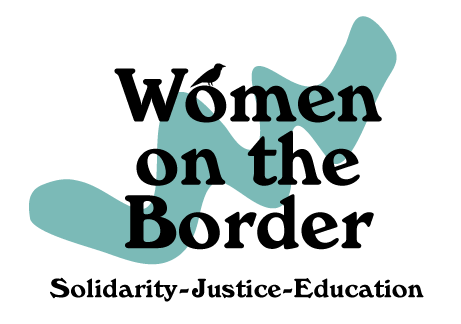
Gendered violence at the border.
Linking the Global Economy to Violence Against Women: The Case of the Ciudad Juarez Murders (2007)
by Elvia Rosales Arriola
The “maquiladora murders” was a popular subject for writing and activism by feminists in the first decade of the 21st century, and an inspiration for numerous forms of art, literary fiction and commentaries, international conferences, movies, and marches on both sides of the border. A 2004 conference held at the University of California-Los Angeles entitled “Maquiladora Murders” drew worldwide attention to the cases of hundreds of young Mexican women who worked in maquiladoras—American-owned transnational factories—and met untimely, often brutal deaths. Who killed them is still a mystery.
What is not a mystery is that incidents of domestic violence and femicide in Ciudad Juárez have risen in the wake of heavy industrialization along the border; that industrialization was a result of the signing of the 1993 North American Free Trade Agreement (NAFTA) between Mexico, the United States, and Canada.
In less than a decade, a city that once had very low homicide statistics now reports that at least 300–400 women and girls were killed in Ciudad Juárez between 1994 and 2000. Some of the murders fell into a bizarre serial killer pattern. Others were suspiciously linked to illegal trafficking gangs. Still others involved abductions of young, female maquiladora workers who never made it to or from work and whose bodies were later found dumped in Lomas de Poleo, the desert that surrounds Ciudad Juárez. They had been raped, beaten, or mutilated.
To be fair, the reference to “maquiladora murders” is a misnomer; not all victims have been workers for the vast number of American companies lining the 2,000-mile border that secures an interdependent economic bond between the United States and Mexico. However, while the exact number of victims is still unknown, of the estimated 300–400 unsolved murders, about one-third involved maquiladora workers. Mexican government officials have not appreciated the negative press surrounding their largest export-processing zone and symbol of participation in the global economy. And the public has not been happy either, confused by seemingly bungled and incompetent investigations. The lack of coordination among public authorities has only worsened the perception that the government is either too corrupt, indifferent, or incompetent to address the problem of systematic violence against women.
In Mexico, the maquiladora worker is typically someone with little education or property, and is often a migrant from even poorer regions of the country that now hosts a conglomerate of factories owned by European, American, and Japanese multinational corporations. Thousands of workers in these factories eke out sad lives in shantytowns without water, electricity, or public lighting. The most recent arrivals to the Mexican frontera find cities that are unable to meet their housing needs. Dozens of families may stake out plots of land near public utilities or industrial parks where they pirate essential public services and live in shacks made of sticks, cardboard, rags, or discarded construction platforms. Some even make their homes next to trash dumps.
Public discourse on the Juárez murders intensified after the 2002 release of the documentary Señorita Extraviada by former Juárez resident and filmmaker Lourdes Portillo. The documentary opens with various shots of factories bearing the names of familiar American companies that sell U.S. consumers everything from cell phones to televisions, stereo equipment, computers, electrical appliances, and toys. Juárez is portrayed as Mexico’s symbol of the failed promises of free trade; in what activists refer to as the “race to the bottom” of the wage scale, investors compete globally and reap huge profits by creating new low-skilled and low-paying jobs for the working classes. Although a political and economic context is critical for grasping the breadth and depth of the gender violence that accompanies globalization, the film does not dwell on this context.
Instead, Señorita Extraviada portrays Juárez as a city out of control, unable to respond to violence against poor working women. Highlighted are images of indigent, powerless, and grieving families confronting law enforcement and political systems that systematically fail them. The violence of poverty, graphically portrayed in Señorita Extraviada, generates rage and fury as the camera pans over crime scenes littered with the shoes, clothes, and jewelry of a girl’s naked, bruised, or mutilated body discovered weeks after her disappearance. In another scene, a coroner confirms that one of the victims in a dual murder case had suffered several massive cardiac arrests as a result of the terror she and the other young girl had experienced in their final moments of life. Each story of grief produces waves of sorrow that spread over the families, the city, and the lost image of the characteristically family-oriented Mexican culture.
The bungled forensic efforts reinforce the violence against the young murder victim who left the house one day and never came home, leaving behind a family desperate for answers and comfort from their community leaders. The film highlights some of the outrageous official responses to the murders. For example, the governor of the State of Chihuahua is shown publicly criticizing the murder victims for the way they dressed or for attending night clubs, thus blaming the victims for their fate and turning the demand for investigations into a mockery of justice. After public outcry, the State appointed a female special prosecutor. However, the State then failed to provide her with sufficient power or money to produce satisfactory leads.
While Señorita Extraviada portrays the problem as the systematic failure of law enforcement and the political system, Diana Washington-Valdez, the reporter who has relentlessly tracked the murders since the early nineties, argues that true justice for the maquiladora murder victims may never come because rampant corruption and secrecy surround efforts to track down the persons responsible for the most chilling serial or ritualistic type killings.
Yet, an important factor is constantly overlooked in the public discourse about the Juárez murders. Few seriously examine the relationship between systematic violence against women and the changes in the social environment of the city that allows such violence to occur. Along Mexico’s border, and especially in Ciudad Juárez, many changes have resulted from the rapid industrialization produced by Mexico’s intense participation in the global economy. The unspoken element of the discourse is the multinational corporations’ complicity with Mexican officials in disregarding the health, safety, and security needs of Mexican women and girls who work in the maquiladoras.
Multinational corporations come into Mexico, lease large plots of land, run their factories twenty hours a day, pay no taxes, and do very little to ensure that the workers they employ will have a roof over their heads, beds to sleep in, and enough money to feed their families. Juárez, like many other border towns affected by NAFTA, may have factories and cheap jobs, but such employment has not enhanced peace and prosperity among the working classes; instead, hostility against the poor working women—who form the majority of those employed by the maquiladoras—has intensified.
The above is taken from the article “Accountability for Murder in the Maquiladoras: Linking Corporate Indifference to Gender Violence at the U.S.-Mexico Border, Vol. 5 Seattle Journal for Social Justice (No. 2 Spring/Summer 2007). Also available in spanish at pp. 113-169 in the book DERECHO, DEMOCRACIA Y ECONOMIA DE MERCADO (Univ. de los Andes, 2010).
